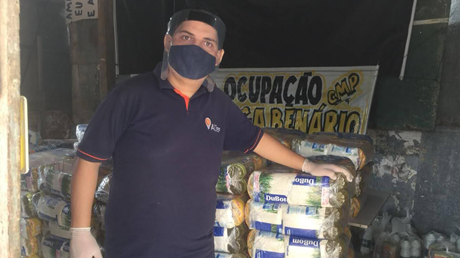
Will you help encourage and connect the church?
Give NowWill you help encourage and connect the church?
Give NowAs a photographer, author, executive, and entrepreneur, Lancia E. Smith is usually the one asking the questions. But for the sake of sharing her enthusiasm for Christianity Today and her long-standing love for the good, true, and beautiful, Smith sat down with CT to discuss how the ministry inspires and motivates her work.
In your mind, what sets Christianity Today apart from other publications?
I'm a longtime fan of Christianity Today and enthusiastic about its work and mission. I see CT as a champion for other people like me in Christian publishing and feel the spiritual covering CT offers. It functions like an icebreaker ship going before so many smaller vessels to break up ice and remove barriers. Because CT has paved the way, it allows people like me to do the kind of work that I do. Its scope, standard of excellence, history, and mission make it unique among publications.
What is your work—what fills your days?
My husband, Peter and I own an environmental consulting and engineering firm in north Denver, of which I am president. My days are spent working in executive management. Additionally, I've worked as staff with the C. S. Lewis Foundation for 12 years and continue to serve there. I am deeply involved with the Anselm Society, based in Colorado Springs, serving as a board member and patron. But much of my working life is spent producing Cultivating, the online quarterly magazine I founded, and running the discipling initiative that stems from it—The Cultivating Project.
Peter and I work hard to foster community with other believers, and that's a large part of why I'm involved with the Anselm Society, whose core mission is a renaissance of the Christian imagination.
Much of what Anselm aims to accomplish is the reconciliation of artist to the church and the church to the artist. That's where we've seen such a huge division over the past 40 or 50 years. I also support the Rabbit Room and am involved with the creative community they're building across the country. I find the parallels with Anselm Society, Rabbit Room, the C. S. Lewis Foundation, and Cultivating to what CT is doing absolutely stunning and inspiring. This is especially true given the mission focus of each organization in reaching both the church and isolated believers and re-engaging them with Beautiful Orthodoxy.
You're an avid supporter of CT's cause of Beautiful Orthodoxy—why does that message resonate with you?
The message of Beautiful Orthodoxy resonates with me because the focus and foundation of it echo my own calling and work. Twelve years ago, when I first launched a blog, the original title was "Cultivating: the Good, the True, the Beautiful." Years later when I first read about Beautiful Orthodoxy, I cried. I realized another band of orthodox believers understands that God must be presented beautifully, that he must be presented in goodness, and that he must be presented in Truth. It was a profound moment to realize that someone else was and is serving this call with me. It still makes me shiver to think about it.
CT's work validates my work in teaching good, true, and beautiful as an approach to not only faith but how we can live an integrated life. The creation of Beautiful Orthodoxy has had a ripple effect through so many places. It's helped to reframe the way we can approach and communicate the gospel: no longer merely asking people if they are saved but drawing people in by what we're sharing. Beautiful Orthodoxy is an evangelistic language echoing back to the first believers living out the gospel. It brings people to Christ—and back to Christ with real joy. If you take beauty and goodness away from truth (which has often been done), the truth not only loses its power to transform, it can become a weapon to alienate.
You've talked with affection about the "nomads" of the Christian faith. Can you tell me more about what draws you to this group and how you see CT as a bridge to reach them?
I feel an affiliation and concern for Christian nomads partly because I am one myself. I know what it is to be displaced. Many Christian nomads happen to be engaged in the fields of creative arts. The more we are restored to our places within the living body of Christ and in community as Christians, the more we will be able to give our gifts to the church and to our very needy culture. When the church loses her artists, as Christians we lose the culture within that generation, too. Goodness, truth, and beauty speak to people in ways that reason alone cannot. If we find avenues to present the truth in winsome ways, we have a greater likelihood of being able to influence and nurture culture. Culture should not be treated as a war zone. Like a garden, culture is something to be tended.
C. S. Lewis wrote, "For me, reason is the natural organ of truth, but imagination is the organ of meaning." Many believers, particularly artists and creative writers, have at times been marginalized within the church. They follow Christ but not in an easily identifiable community of believers. One of the great assets I see in Christianity Today is being able to go into the homes of believers across the world, regardless of church affiliation or engagement. CT allows us to listen in on the way God is working in different groups and regions through the filter of what's good and true and beautiful. It doesn't just talk about Beautiful Orthodoxy in theory, CT models it in practice. I see it in the articles they publish, the people CT employs, and in the kinds of campaigns they support. CT's This Is Our City is the film series that first reflected this to me, but that has been underscored many times since.
What are your influences as the founder of Cultivating and The Cultivating Project, and how do you see Christianity Today or Beautiful Orthodoxy specifically shaping your work?
As the founder of Cultivating, I have many sources of influence and inspiration, and Christianity Today is one of them. I resonate strongly with its core mission and have since I became a believer over 48 years ago, long before the phrase Beautiful Orthodoxy existed. As publisher of Cultivating, my purpose is to spark courage and inspiration in believers who are engaged in creative endeavors but also for teachers, spiritual directors, and pastors, much like CT does.
Cultivating, as the online publication, serves as the house for The Cultivating Project, which is effectively the family that lives within it. The Cultivating Project is a unique discipleship initiative that gathers a team reflecting varied creative disciplines to intentionally develop the three C's: craft, character, and community. As someone engaged in the arts, it's been my observation that if we don't carefully develop these three, we won't be truly whole as human beings or as craftsmen. We must cultivate the balance of those three C's. I think that's true for everyone, whether in the arts or other fields.
Christianity Today influences my work with Cultivating by offering a reliable standard not only in the quality of writing and balanced perspectives but also in training within the organization to live up to those same standards of excellence. The Cultivating Project endeavors to do the same. CT has high standards of what it means to treat people fairly, to listen, to love, and to be motivated by the truth. All of this is tempered with tenderness in the lives of their staff. The bravery that Christianity Today demonstrates in this gives me comfort in the publishing world. While they are not without fear, CT moves beyond the fear to focus on a greater call. The courage CT models in the global view of the world and Christianity as a whole makes me feel less alone.
Why are you a Sustaining Partner of Christianity Today?
Christianity Today is critical because it's reaching those who really need it within the church and beyond. It specifically reaches leaders—one of the most underserved groups in the body.
Champion is the word I always think of when I think of CT. If there's anyone, any organization, that is a champion for me, it's Christianity Today. Beautiful Orthodoxy's influence is spreading like rain onto dry land. What does rain do when it falls in a desert? It awakens the desert to bloom. We live in a time that is a vast desert of postmodernism. It is our business as believers to irrigate the desert. Every issue of CT is doing that—watering the desert and inspiring those who labor to do redemptive work. CT is a voice of clarity, courage, and compassion. That's why it's so vital to support this ministry.
Joy Beth Smith is an associate editor of Christianity Today.







